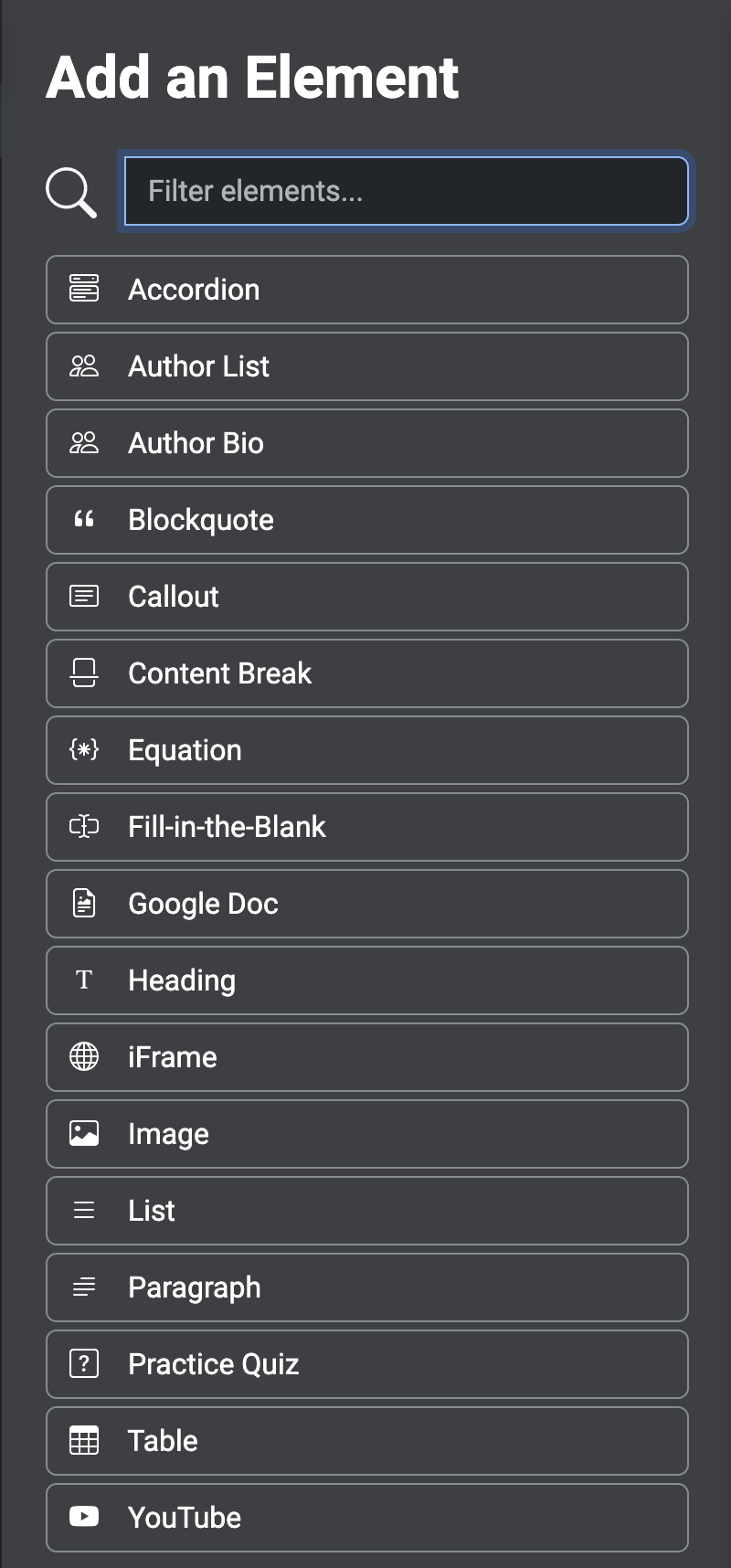Lesson 1, Part 2: Include a Variety of Features
The Value of Variety
When creating content, EdTech Books offers a wide array of media options. As you plan your book or journal, consider incorporating not only text but also various media elements that can add greater depth to your content, such as videos, practice questions, and callout boxes.
This page will provide an overview of the features available on EdTech Books. While there is no obligation to use all of the features, choose the ones you believe will benefit your readers the most.
Your Objectives
- Identify and understand a variety of product features (e.g., embedded YouTube videos, callout boxes, practice quizzes, etc.).
- Select a variety of features to include in your publication that will benefit your readers.
Possible Features
Continue reading for a brief explanation of each feature available on EdTech Books. Consider the needs of your particular audience and the author of your publication while reading through the list of features. You may not end up using all of these features in your content, but it’s worthwhile to read the description of each to understand what’s available.
- Paragraph Editing
- Blockquote
- Headings
- Lists
- Callout Boxes
- Images
- Practice Questions
- Accordions
- Equations
- iFrame
- Youtube Video
- Google Doc
- Table
Paragraph Editing
EdTech Books utilizes a text editor similar to Google Docs or Microsoft Word, allowing you to format your content. It includes standard features such as:
- Underlined
- Bolding
- Italicizing
Blockquote
"If there is one thing Voldemort cannot understand, it is love. He didn't realize that love as powerful as your mother's for you leaves its own mark. Not a scar, no visible sign… to have been loved so deeply, even though the person who loved us is gone, will give us some protection forever. It is in your very own skin" (Rowling, 241).
📍 For step-by-step instructions on how to add a blockquote, visit the EdTech Books user guide.
Headings
In addition to making your product more visually appealing, headings are important to facilitate accessibility for those who use screen readers. Below are the different heading options.
Level 2
Level 3
Level 4
Level 5
Level 6
Make sure to use headings consistently throughout your content. For example, use the same level of heading for items that belong to the same category or hierarchy.
📍 For step-by-step instructions on how to add headers, visit the EdTech Books User Guide.
Lists
You can include bulleted or numbered lists to organize content into easily readable content.
- Colors
- Blue
- Green
- Orange
How to make a PB&J sandwich
- Take out two pieces of bread
- Spread jam on one side of a piece of bread
- Spread peanut butter on the other piece of bread
- Put the pieces of bread together, with the peanut butter and jam touching in the middle.
Callout Boxes
Callout boxes (see example below) can be used to draw attention to information that you want to stand out to readers. In each callout box, there is a header and a body section.
Callout Box Header
The body of your callout box. In this space, you can include:
- Text
- Lists
- Images
- Videos
- Embedded Content
For step-by-step instructions on how to create callout boxes, visit the EdTech Books User Guide.
Images

Images can be used to engage the reader and provide valuable context. You may add graphs, infographics, or other images to enhance your content. If you are looking for images, you may consider using royalty-free images that can be found on websites such as these:
For step-by-step instructions on how to add images, visit the EdTech Books User Guide.
Practice Questions
Including practice questions in your content is a good way to keep your learners accountable. While these answers aren’t recorded anywhere for the author to see, this is still a valuable way for learners to assess their learning. You can include both fill-in-the-blank and multiple-choice questions.
Fill-in-the-blank Example
Fill in the blanks in the following nursery rhyme.
Roses are, violets are.
Multiple Choice Example
How do you say "Thank You" in Spanish?
- Obrigado
- Merci
- Gracias
For step-by-step instructions on how to create practice questions, visit the EdTech Books User Guide.
Accordions
Accordions (see example below) can be used as a way to organize information and to help not overload your readers with too much information at one time. It essentially can hide information until the reader wants to access it.
If you choose to use an accordion, make sure to include instructions on what you want your readers to do with the accordion. For example:
Today, we are learning about the origins of fruit. Please take time to read about the origins of ONE of the following fruits. To read more about a fruit, simply click on its name.
Watermelon originated in Africa, where it was first cultivated over 4,000 years ago. Ancient Egyptians are believed to have grown and consumed watermelon as a source of hydration in the hot climate.
Strawberries are native to temperate regions of the Northern Hemisphere, with early cultivation traced back to ancient Rome. The modern garden strawberry, as we know it today, was developed in France in the 18th century through the hybridization of wild varieties.
Equations
If desired, you can include mathematical equations (see example below) in your content.
Iframe - Embedded Content
An iframe is a tool used on websites to display content from another source, like a video or another webpage, within the current page. It allows users to view additional content without leaving the site they’re on. With permission from the creator, you can embed content from another website in your publication.
YouTube Videos
Videos are valuable as they can provide context and instruction that pictures and text cannot.
There is no transcript for this video because there are no words.
For step-by-step instructions on how to embed YouTube videos in your content ,visit the User Guide.
Google Docs
Google Docs can easily be embedded on a page, providing an opportunity for ready to collaborate or quickly copy a document for their own use.
You can also import the content from the Google Doc so that it resides as static HTML in the chapter.Table
Tables can be used in your publication to organize information clearly. For example, here is a table that lists a variety of world record holders:
| Record Category | Record Holder |
|---|---|
| Longest Time Holding Breath | Aleix Segura Vendrell |
| Tallest building | Burj Khalifa |
| Fastest 100m sprint | Usain Bolt |
| Most pizza eaten in 10 min | Joey Chestnut |
In Conclusion
As you consider these options, it is important to take into account these three tips:
- Don't feel like you have to use every feature.
- Take time now to select which features will benefit your learners.
- Don't be afraid to try a feature that you are unfamiliar with.
Project Application Question
Consider your specific publication and audience. What features do you want to include? How will you use these features to meet your learners' needs?
Next - Lesson 1: Organizing Your Content Badge
Now that you have completed Lesson 1, Part 2, move on to Lesson 1: Organizing Your Content Badge.
Reference
Rowling, J.K. Harry Potter and the Philosopher’s Stone. Bloomsbury, 1997, p. 241.
